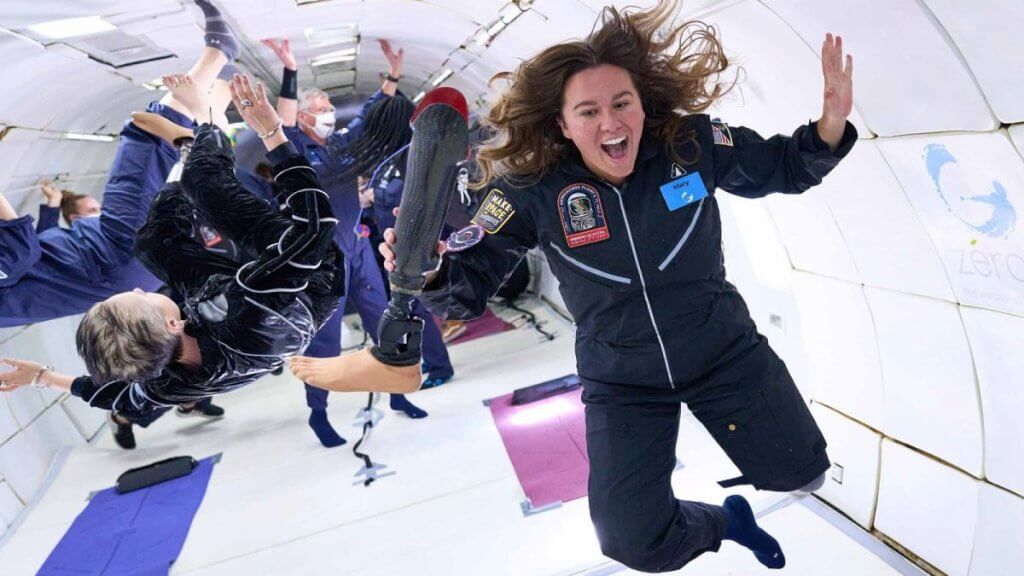
Zero-gravity parabolic flights get surge of demand for spaceflight work (Image Credit: Space.com)
A senior executive at Zero-G loves watching first-time customers on her company’s parabolic airplane flights.
When clients float in the air like astronauts, “there is a wonder that comes out in people’s faces, where they become child-like,” Allison Odyssey, Zero-G’s chief operating officer, told Space.com.
Odyssey was one of Zero-G’s first employees in 2004 and stayed for three years, before departing for other space ventures. She came back to the company in 2020, after the space industry had matured considerably. Joining the joyriding clients were new types of people seeking access to microgravity, even if it’s just for a few seconds at a time.
Related: I flew weightlessly on a Zero-G plane and it was nothing like I expected
Zero-G (short for “zero gravity”) uses a specially modified Boeing 727 that arcs in 15 or more parabolas (opens in new tab) across the sky, allowing customers to experience weightlessness for about 20 to 30 seconds at a time. (Flight profiles can be customized for customer needs, too.)
To get to the parabola-flying altitude, the plane climbs at 45 degrees relative to the horizon; customers experience almost double the normal force of Earth’s gravity during the ascent. Ticket prices start at about $9,000. While that’s a pretty penny for most of us, it’s a tiny fraction of the $450,000 a Virgin Galactic customer would pay for a brief flight to suborbital space.
Companies wanting to run experiments in space use these parabolic flights to allow for instant adjustments on-site, before sending the payload to orbit where troubleshooting is difficult. The surging launch industry is adding more of this research work to Zero-G’s manifest, Odyssey said.
There also is a new breed of private astronauts who need training to feel confident in orbit’s microgravity conditions. These include ventures like the Inspiration4 mission of 2021 or the Polaris Dawn flight set to launch this year (both bankrolled by billionaire Jared Isaacman), or the commercial company Axiom Space that sends private astronaut missions to the International Space Station. All of these entities used, or will use, SpaceX rockets and spacecraft.

Equity and inclusion are also at the forefront these days, particularly through the nonprofit organization AstroAccess, which pays for “disability inclusion” flights. These opportunities allow folks to access Zero-G flights for research and also experience the joy of moving their bodies in different ways than they experience on Earth.
“I feel like we change lives and open eyes all the time, but it’s especially important for people that don’t necessarily get to be included in everything,” Odyssey said. Zero-G has seen substantial growth in the past year to accommodate all this demand; the company now has 25 employees, up from 15 not too long ago.
Related: Zero-G flight for disability ambassadors shows space is accessible for all

The latest business line for Zero-G involves offering in-flight studio recording for musicians, which will require further modification of the company’s 727. There’s ample space available already to carry musical instruments, Odyssey said, but the company plans to blanket the plane in an advanced material that promotes good sound and heat insulation.
Insulation will be a boon to all customers when the plane is ready, she added, as normally there is a huge temperature swing between flying at 35,000 feet (10,700 meters) and the ground — especially in the heat-soaked Floridian summer. (Zero-G has one plane but flies it at multiple locations around the United States; it departs from spots like Seattle, Houston, Newark, NASA’s Kennedy Space Center in Florida, and Long Beach in California.)
Odyssey acknowledged that the company is lucky to be doing so well today; the coronavirus pandemic forced a five-month shutdown in 2020, but Zero-G “weathered the storm” because customers continued to book flights. The company also received a loan from the Paycheck Protection Program, which was a temporary U.S. government program aiming to help small businesses keep their workforceds employed in the pandemic’s early phase.
When Zero-G resumed flights in August 2020, the company also implemented temporary strict protocols including masking and testing, and no one ever tested positive as a result of a flight, Odyssey said. Meanwhile, experiment types have proliferated, including 3D-printing an artificial human heart during a set of flights, along with aspects like space manufacturing, or surgery techniques for deep space travel.
Odyssey said that the number of markets the company expects to serve will probably expand as the space industry continues to grow. “I feel like we’re just scratching the surface, even though we’ve been flying for 19 years,” she said.
Elizabeth Howell is the co-author of “Why Am I Taller (opens in new tab)?” (ECW Press, 2022; with Canadian astronaut Dave Williams), a book about space medicine. Follow her on Twitter @howellspace (opens in new tab). Follow us on Twitter @Spacedotcom (opens in new tab) or Facebook (opens in new tab).








